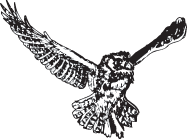

American Kestrel
(Falco sparverius)
Falcons are the most streamlined raptors, with long pointed wings and long, narrow tails. They are fast agile fliers who feed mostly on other birds they capture in open areas.
The American Kestrel is North America's smallest falcon and also is known as the Sparrow Hawk. American Kestrels are the most abundant of the North American hawks and as a whole their population is stable.

The American Kestrels have sexually dimorphic plumage. The males have bluish gray upper wings and a reddish brown tail. Females have reddish brown upper wings and tail, both of which are narrowly banded with black. Both sexes have a conspicuous black nape and ear patches, and a black "mustache."
Kestrels are very vocal in all seasons. When alarmed, the birds utter rapidly, high-pitched "klee" or "killy" notes.
Male kestrels' average weight is about 115 grams (4 ounces) while females average about 130 grams (5 ounces). This is the only North American raptor with circular nostrils and a wing length of no more than 207 millimeters (4 inches).
The American Kestrel regularly perches on utility wires while larger hawks typically perch on posts or poles. It is often mistakenly identified as a killdeer or mourning dove. Kestrels pump their tail up and down repeatedly right after landing or while perched on utililty wires. They also move their heads up and down ("bop" their heads) as they measure the distance to the prey they are watching. Killdeer and mourning doves do neither of these activities.
The ideal habitat for kestrels is open areas with few trees, forest edges near open areas, suburbs, or parks in cities. Kestrels are cavity nesters, depending on woodpeckers to excavate nest sites (especially flickers). They will readily use nest boxes when they are provided. Pair bonding in kestrels is strong and tends to be permanent. Courtship feeding strengthens the bonding and helps ensure the success of the single clutch of 4-5 eggs.
Kestrels are generally migratory, however adults breeding in southern states usually do not migrate. Fall migration is mid-August to mid-October and spring migration usually occurs from mid-March to mid-May.
Kestrels are perch and aerial hunters. They eat insects, small rodents, songbirds, small amphibians and reptiles, and occasionally small bats. They rarely eat carrion. Most of the kestrel's prey (often large insects) is captured by pinning it to the ground rather than during aerial chases. Kestrels commonly hover when hunting. Kiting may occur for short periods between hovering, especially in strong winds. Extra prey animals may be stored (cached).
Competition for nest sites with dominant cavity-nesting species of birds and mammals has had a negative impact on American Kestrel reproductive success. Also, the loss of dead trees for nest sites has probably been a factor. Kestrels are a highly adaptable species and readily acclimate to human-altered habitats, provided suitable nest sites and foraging habitats are available. Kestrels have undoubtedly benefited from the deforestation of much of the eastern United States, which considerably expanded semi-open habitat. Some mortality occurs from illegal shooting, organophosphates pesticides from insect and rodent poisoning and from collisions with vehicles on expressways.